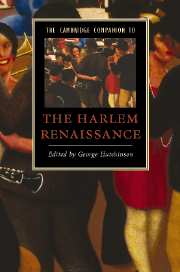Book contents
- Frontmatter
- Introduction
- Part I: Foundations of The Harlem Renaissance
- Part II: Major Authors and Texts
- 4 Negro drama and the Harlem Renaissance
- 5 Jean Toomer and the avant-garde
- 6 “To tell the truth about us”: the fictions and non-fictions of Jessie Fauset and Walter White
- 7 African American folk roots and Harlem Renaissance poetry
- 8 Lyric stars: Countee Cullen and Langston Hughes
- 9 “Perhaps Buddha is a woman”: women’s poetry in the Harlem Renaissance
- 10 Transgressive sexuality and the literature of the Harlem Renaissance
- 11 Sexual desire, modernity, and modernism in the fiction of Nella Larsen and Rudolph Fisher
- 12 Banjo meets the Dark Princess: Claude McKay, W. E. B. Du Bois, and the transnational novel of the Harlem Renaissance
- 13 The Caribbean voices of Claude McKay and Eric Walrond
- 14 George Schuyler and Wallace Thurman: two satirists of the Harlem Renaissance
- 15 Zora Neale Hurston, folk performance, and the “Margarine Negro”
- Part III: The Post-Renaissance
- Further Reading
- Index
4 - Negro drama and the Harlem Renaissance
from Part II: - Major Authors and Texts
Published online by Cambridge University Press: 28 July 2007
- Frontmatter
- Introduction
- Part I: Foundations of The Harlem Renaissance
- Part II: Major Authors and Texts
- 4 Negro drama and the Harlem Renaissance
- 5 Jean Toomer and the avant-garde
- 6 “To tell the truth about us”: the fictions and non-fictions of Jessie Fauset and Walter White
- 7 African American folk roots and Harlem Renaissance poetry
- 8 Lyric stars: Countee Cullen and Langston Hughes
- 9 “Perhaps Buddha is a woman”: women’s poetry in the Harlem Renaissance
- 10 Transgressive sexuality and the literature of the Harlem Renaissance
- 11 Sexual desire, modernity, and modernism in the fiction of Nella Larsen and Rudolph Fisher
- 12 Banjo meets the Dark Princess: Claude McKay, W. E. B. Du Bois, and the transnational novel of the Harlem Renaissance
- 13 The Caribbean voices of Claude McKay and Eric Walrond
- 14 George Schuyler and Wallace Thurman: two satirists of the Harlem Renaissance
- 15 Zora Neale Hurston, folk performance, and the “Margarine Negro”
- Part III: The Post-Renaissance
- Further Reading
- Index
Summary
Dramatists of the Harlem Renaissance (c. 1916-35) sought to eradicate the legacy of minstrelsy. American minstrelsy began in the late 1820s and consisted in white actors applying burnt cork to their faces in degrading portrayals of African Americans. This created a cultural lexicon of stereotypes. Eliminating the century-long shroud of minstrel theater became one of the goals of Harlem Renaissance dramatists. Willis Richardson, author of the first African American non-musical drama on Broadway, said in 1919 that “When I say Negro plays, I do not mean merely plays with Negro characters,” but dramas portraying “the soul of a people.” Indeed, it was part of the “New Negro” agenda to lay bear the “people's soul.” Plays conveyed the principles of the “New Negro” by portraying characters having moral values, familial bonds, education, dignity, integrity, and work ethic. “Negro life,” Alain Locke noted in his “Introduction” to the era's influential The New Negro (1925), “is not only establishing new contacts and founding centers, it is finding a new soul.”
Creating the New Negro “soul” onstage, however, proved no simple undertaking. Several factors had to be considered, among them: how should blacks be portrayed - with idealization or bluntness; and what was drama's function - to protest racism or to convey the ordinary folk? James Weldon Johnson added in 1928 that the African American author “faces a special problem which the plain American author knows nothing about - the problem of the double audience; it is a divided audience, an audience made up of two elements with differing and often opposite and antagonistic points of view.”
- Type
- Chapter
- Information
- The Cambridge Companion to the Harlem Renaissance , pp. 57 - 70Publisher: Cambridge University PressPrint publication year: 2007
- 2
- Cited by



